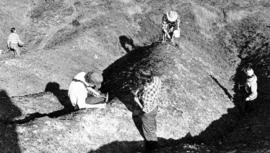This collection contains the professional work papers of Minnesota historical archaeologist Douglas A. Birk. Records include fieldwork, research notes, correspondence, writings, and subject files. Topics include the history of the fur trade and the archaeological record of central and northern Minnesota.
Record Group 1: Career files represents an overview of Birk’s professional activities. Series within this group include general correspondence, an incomplete but substantial collection of Birk’s writings, records of presentations given, conferences attended, and newspaper clippings documenting his career. Importantly, this group includes Birk’s field journals/log books and daily journals. The former document Birk’s activities at archaeological sites and includes an index of all field journal entries contained throughout the paper collection, cross referenced by location and date.
Record Group 2: Research files are arranged by topic and cover Birk’s areas of professional expertise. Prominent topics include the archaeological record of sites within the LEHP, especially 21MO20; Minnesota’s Colonial and Territorial periods; John Sayer; Zebulon Pike; Protestant missions; mounds; historic communities; historic transportation routes; and journals, artifact studies, and sites relating to the fur trade in Minnesota. Records within each series include fieldwork, correspondence, project documentation, copies of primary and secondary source documents, and research notes. Content notes are also provided at the series level, as the details of each series varies. Birk maintained these files throughout his career and most series include records spanning multiple decades.
Record Group 3: Work files are primarily the institutional records of Birk’s employers that Birk retained in his personal files. Records in this group are divided into series representing each employer. Records within series are mostly arranged by type and/or function rather than topic and include correspondence, board minutes, financials, project files, and public relations. This group also includes Birk’s educational records from junior college to graduate school.
Record Group 4: Subject files functions as a “catch-all” category for records that are broadly organized by subject and do not fit within the preceding groups. These include records of Birk’s involvement with local historical societies, material on professional standards and legal requirements, and miscellany.
Record Groups 5-7 represent special format records and do not relate to the intellectual arrangement of the collection. See the arrangement and access notes for more details.
Researchers are encouraged to search this finding aid thoroughly and consider all areas of the collection were information relevant to their research interest may be found. For instance, while research material on a particular topic may be concentrated in the relevant series in group 2, a finished publication stemming from this research is likely to be located in group 1. Meanwhile, correspondence and other documentation of the context of a research project may be located in group 1, 2, or 3 under various series.
Zonder titel